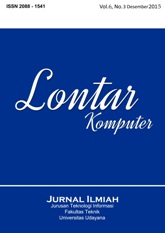Implementasi Metode Clustering DBSCAN pada Proses Pengambilan Keputusan
Abstract
Spatial Data Clustering is one of the significant techniques in data mining which used to obtain information or knowledge in a large number of spatial data from various applications. One technique that being a pioneer in the development of spatial data clustering algorithm is DBSCAN. This study is focused on implementation of DBSCAN method in decision making process in order to help a company to decide its potential customer. The trial results in this study show that DBSCAN method has been successfully conduct clustering process to support decision making process in determination of potential customer by forming several number of clusters.
Downloads
References
[2] Shekhar S, Zhang P, Huang Y, and Vatsavai RR, “Trends in spatial data mining. Data mining: Next generation challenges and future directions,” pp. 357–380, 2003.
[3] Matheus CJ, Chan PK, and Piatetsky-Shapiro G, “Systems for Knowledge Discovery in Databases,” IEEE Trans. Knowl. Data Eng., vol. 5, no. 6, pp. 903–913, 1993.
[4] Mumtaz K, “An Analysis on Density Based Clustering of Multi Dimensional Spatial Data,” Indian Journal of Computer Science and Engineering (IJCSE), vol. 1, no. 1, pp. 8–12, 2010.
[5] Zakrzewska D and Murlewski J, “Clustering Algorithms for Bank Customer Segmentation,” in Proceedings of 5th Int. Conference on Intelligent Systems Design and Applications, Poland, 2005, pp. 197–202.
[6] H. Xiaohui, “A New Customer Segmentation Framewok Based on Biclustering Analysis,” J. Softw., vol. 9, no. 6, pp. 1359–1366, 2014.
[7] P. Tan, Introduction to Data Mining. Boston: Pearson Education, 2006.
The Authors submitting a manuscript do so on the understanding that if accepted for publication, the copyright of the article shall be assigned to Jurnal Lontar Komputer as the publisher of the journal. Copyright encompasses exclusive rights to reproduce and deliver the article in all forms and media, as well as translations. The reproduction of any part of this journal (printed or online) will be allowed only with written permission from Jurnal Lontar Komputer. The Editorial Board of Jurnal Lontar Komputer makes every effort to ensure that no wrong or misleading data, opinions, or statements be published in the journal.
 This work is licensed under a Creative Commons Attribution 4.0 International License.
This work is licensed under a Creative Commons Attribution 4.0 International License.























